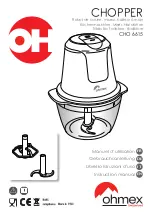
20
The value you select for the slope depends heavily on the type of application.
The following points may aid your decision:
• The steeper the slope, the worse the filter impulse behavior.
• The preferred level for the subwoofer channel low-pass filter is “-24 dB”.
•
Standard values for the crossover between the woofer and the tweeter in fully active systems
lie around “-12 dB”.
•
If the woofer exhibits considerable lack of clarity in the frequency response slightly above the
set crossover frequency, it may be useful to select a steep slope (e.g. -24 dB per octave) for
the low-pass filter.
•
A small 19 mm tweeter operated in a fully active system at up to 3000 Hz also requires a stee-
per slope (-18 dB to -24 dB) to avoid overloading the woofer and causing a considerable distor-
tion factor.
• In most instances, a high-pass filter for a woofer or subwoofer is sufficiently dimensioned with
“-12 dB” and is only necessary when small loudspeaker systems are used.
•
A lower slope steepness of just “-6 dB” in fully active systems is to be used with caution, par-
ticularly with tweeters, and are only useful in combination with a suitably selected crossover
frequency.
Important information:
• If you have selected the “Linkwitz” filter characteristics, you are only able to set the values to
“-12 dB” and “-24 dB”.
• The “Self-Define” characteristics always has a slope of -12 dB per octave.
Fig. 4:
Effect of slope on the low-pass
















































